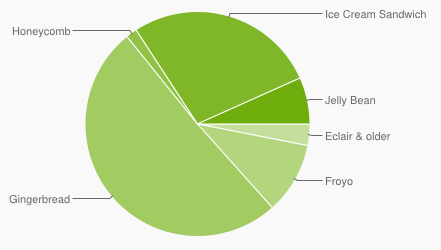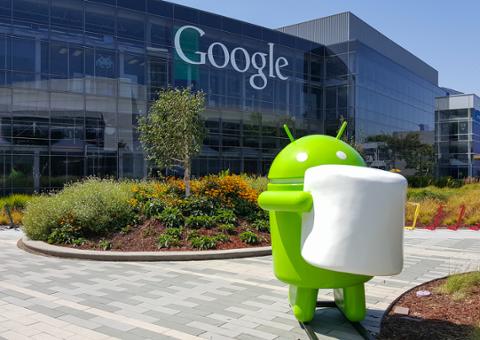 Google Android’s dominance of the smartphone space has been reinforced by a new IDC study that places its market-share at 68.3 percent, well ahead of iOS at 18.8 percent. But which version of Android is most preferred by users? A new set of graphs on the Android Developers Website offers the answer to that question: “Gingerbread,” or Android versions 2.3 through 2.3.7, dominates with 50.8 percent of the Android pie. “Ice Cream Sandwich,” or versions 4.0.3 through 4.0.4, is second with 27.5 percent, with the latest “Jelly Bean” build at 6.7 percent. “Éclair,” or Android version 2.1, runs on 2.7 percent of all Android smartphones; “Froyo,” or version 2.2, runs on 10.3 percent. Combine that with Gingerbread’s percentage, and it’s clear that a lot of Android users are running aged versions of the software on their devices. The data is based on Android devices accessing Google Play within a 14-day period ending December 3. "Underpinning the worldwide smartphone market is a constantly shifting mobile operating system landscape," Ramon Llamas, research manager with IDC's Mobile Phone team, wrote in a statement attached to IDC’s data. "Android is expected to stay in front, but we also expect it to be the biggest target for competing operating systems to grab market share.” The firm expects Microsoft’s Windows Phone and Research In Motion’s BlackBerry 10 to make significant plays for at least a portion of Android’s overall market share. It also believes that iOS will continue as a strong competitor throughout the forecast period, which extends through 2016. “The popularity of the iPhone across multiple markets will drive steady replacements and additional carrier partners will help Apple grow iOS volume,” read IDC’s note. “However, the high price point of the iPhone relative to other smartphones will make it cost prohibitive for some users within many emerging markets.” Android smartphones, built by many vendors and targeted at a wide range of prices and markets, don’t have that problem. However, Android does face one significant issue in the months and years ahead: fragmentation. As demonstrated by that graph on the Android Developers Website, there are a lot of devices running a lot of different versions of Android out there in the ecosystem, all with different capabilities and bugs. In turn, that could make it difficult for Google to deliver “the latest and greatest” to any customer that wants it, and potentially irritates those customers who buy a smartphone (particularly a high-end one) expecting regular upgrades. Image: Android Developer Website
Google Android’s dominance of the smartphone space has been reinforced by a new IDC study that places its market-share at 68.3 percent, well ahead of iOS at 18.8 percent. But which version of Android is most preferred by users? A new set of graphs on the Android Developers Website offers the answer to that question: “Gingerbread,” or Android versions 2.3 through 2.3.7, dominates with 50.8 percent of the Android pie. “Ice Cream Sandwich,” or versions 4.0.3 through 4.0.4, is second with 27.5 percent, with the latest “Jelly Bean” build at 6.7 percent. “Éclair,” or Android version 2.1, runs on 2.7 percent of all Android smartphones; “Froyo,” or version 2.2, runs on 10.3 percent. Combine that with Gingerbread’s percentage, and it’s clear that a lot of Android users are running aged versions of the software on their devices. The data is based on Android devices accessing Google Play within a 14-day period ending December 3. "Underpinning the worldwide smartphone market is a constantly shifting mobile operating system landscape," Ramon Llamas, research manager with IDC's Mobile Phone team, wrote in a statement attached to IDC’s data. "Android is expected to stay in front, but we also expect it to be the biggest target for competing operating systems to grab market share.” The firm expects Microsoft’s Windows Phone and Research In Motion’s BlackBerry 10 to make significant plays for at least a portion of Android’s overall market share. It also believes that iOS will continue as a strong competitor throughout the forecast period, which extends through 2016. “The popularity of the iPhone across multiple markets will drive steady replacements and additional carrier partners will help Apple grow iOS volume,” read IDC’s note. “However, the high price point of the iPhone relative to other smartphones will make it cost prohibitive for some users within many emerging markets.” Android smartphones, built by many vendors and targeted at a wide range of prices and markets, don’t have that problem. However, Android does face one significant issue in the months and years ahead: fragmentation. As demonstrated by that graph on the Android Developers Website, there are a lot of devices running a lot of different versions of Android out there in the ecosystem, all with different capabilities and bugs. In turn, that could make it difficult for Google to deliver “the latest and greatest” to any customer that wants it, and potentially irritates those customers who buy a smartphone (particularly a high-end one) expecting regular upgrades. Image: Android Developer Website Android Rules Smartphones, But Which Version?
 Google Android’s dominance of the smartphone space has been reinforced by a new IDC study that places its market-share at 68.3 percent, well ahead of iOS at 18.8 percent. But which version of Android is most preferred by users? A new set of graphs on the Android Developers Website offers the answer to that question: “Gingerbread,” or Android versions 2.3 through 2.3.7, dominates with 50.8 percent of the Android pie. “Ice Cream Sandwich,” or versions 4.0.3 through 4.0.4, is second with 27.5 percent, with the latest “Jelly Bean” build at 6.7 percent. “Éclair,” or Android version 2.1, runs on 2.7 percent of all Android smartphones; “Froyo,” or version 2.2, runs on 10.3 percent. Combine that with Gingerbread’s percentage, and it’s clear that a lot of Android users are running aged versions of the software on their devices. The data is based on Android devices accessing Google Play within a 14-day period ending December 3. "Underpinning the worldwide smartphone market is a constantly shifting mobile operating system landscape," Ramon Llamas, research manager with IDC's Mobile Phone team, wrote in a statement attached to IDC’s data. "Android is expected to stay in front, but we also expect it to be the biggest target for competing operating systems to grab market share.” The firm expects Microsoft’s Windows Phone and Research In Motion’s BlackBerry 10 to make significant plays for at least a portion of Android’s overall market share. It also believes that iOS will continue as a strong competitor throughout the forecast period, which extends through 2016. “The popularity of the iPhone across multiple markets will drive steady replacements and additional carrier partners will help Apple grow iOS volume,” read IDC’s note. “However, the high price point of the iPhone relative to other smartphones will make it cost prohibitive for some users within many emerging markets.” Android smartphones, built by many vendors and targeted at a wide range of prices and markets, don’t have that problem. However, Android does face one significant issue in the months and years ahead: fragmentation. As demonstrated by that graph on the Android Developers Website, there are a lot of devices running a lot of different versions of Android out there in the ecosystem, all with different capabilities and bugs. In turn, that could make it difficult for Google to deliver “the latest and greatest” to any customer that wants it, and potentially irritates those customers who buy a smartphone (particularly a high-end one) expecting regular upgrades. Image: Android Developer Website
Google Android’s dominance of the smartphone space has been reinforced by a new IDC study that places its market-share at 68.3 percent, well ahead of iOS at 18.8 percent. But which version of Android is most preferred by users? A new set of graphs on the Android Developers Website offers the answer to that question: “Gingerbread,” or Android versions 2.3 through 2.3.7, dominates with 50.8 percent of the Android pie. “Ice Cream Sandwich,” or versions 4.0.3 through 4.0.4, is second with 27.5 percent, with the latest “Jelly Bean” build at 6.7 percent. “Éclair,” or Android version 2.1, runs on 2.7 percent of all Android smartphones; “Froyo,” or version 2.2, runs on 10.3 percent. Combine that with Gingerbread’s percentage, and it’s clear that a lot of Android users are running aged versions of the software on their devices. The data is based on Android devices accessing Google Play within a 14-day period ending December 3. "Underpinning the worldwide smartphone market is a constantly shifting mobile operating system landscape," Ramon Llamas, research manager with IDC's Mobile Phone team, wrote in a statement attached to IDC’s data. "Android is expected to stay in front, but we also expect it to be the biggest target for competing operating systems to grab market share.” The firm expects Microsoft’s Windows Phone and Research In Motion’s BlackBerry 10 to make significant plays for at least a portion of Android’s overall market share. It also believes that iOS will continue as a strong competitor throughout the forecast period, which extends through 2016. “The popularity of the iPhone across multiple markets will drive steady replacements and additional carrier partners will help Apple grow iOS volume,” read IDC’s note. “However, the high price point of the iPhone relative to other smartphones will make it cost prohibitive for some users within many emerging markets.” Android smartphones, built by many vendors and targeted at a wide range of prices and markets, don’t have that problem. However, Android does face one significant issue in the months and years ahead: fragmentation. As demonstrated by that graph on the Android Developers Website, there are a lot of devices running a lot of different versions of Android out there in the ecosystem, all with different capabilities and bugs. In turn, that could make it difficult for Google to deliver “the latest and greatest” to any customer that wants it, and potentially irritates those customers who buy a smartphone (particularly a high-end one) expecting regular upgrades. Image: Android Developer Website 